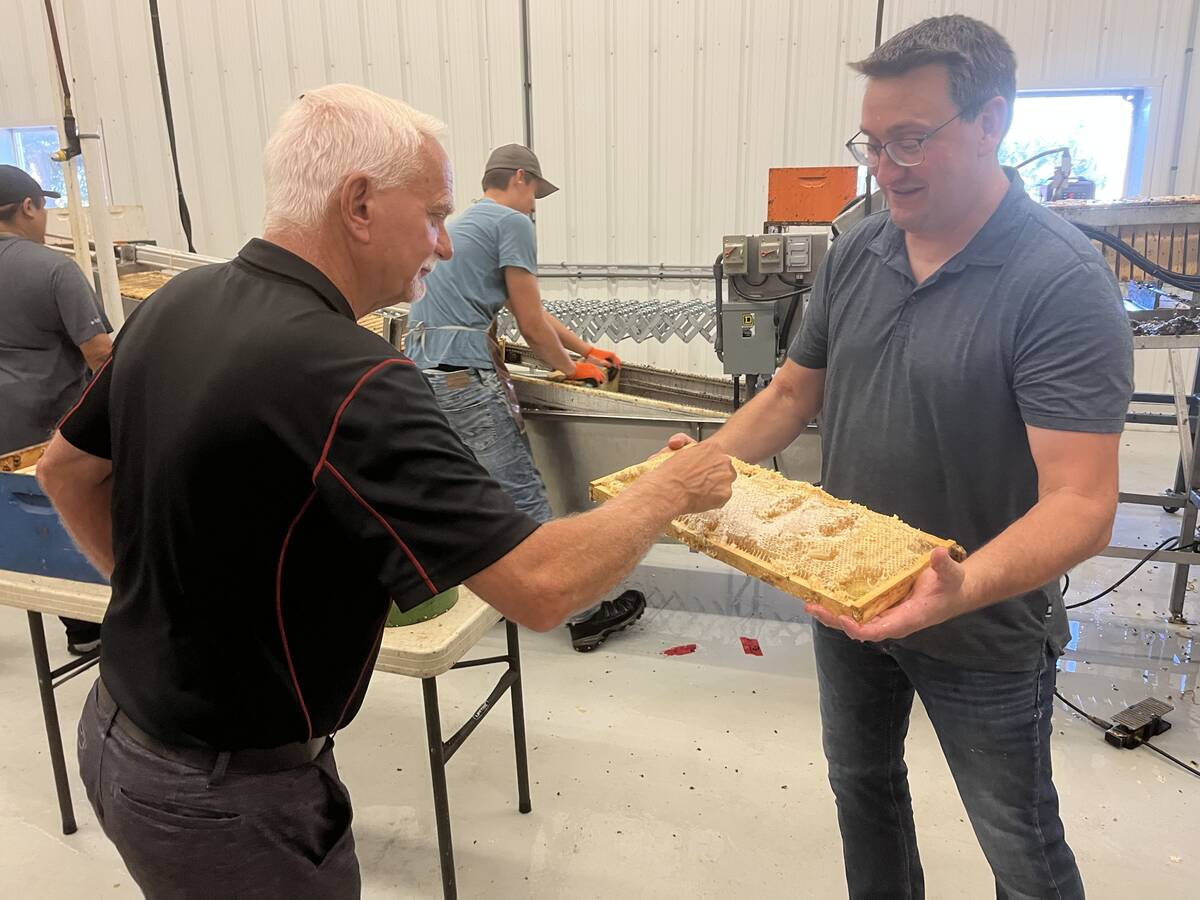What a beautiful autumn Thanksgiving day. It is bright, sunny and warm. Those farmers who haven’t finished their harvest are working hard combining and bringing in the bales. We dug the last of our carrots and potatoes and now have a winter supply tucked away.
This year I feel thankful because our boys have come home for the holidays. There is such a sense of peace to know that our three kids are all sleeping under the same roof with us again, even if it is just for a couple of days.
Read Also

Alberta honey business ‘thrives’ despite bumpy beginnings
Thrive Honey showcases its honey production in market where Alberta produces 40 per cent of all honey produced in the country
I am also thankful because several friends and my family helped me celebrate my birthday. The number 50 really doesn’t mean a lot to me except that I feel healthier and happier than I did when I was 40 and I plan to enjoy life more each day. I don’t believe you should wait for the “big” numbers like 40 or 50 or the 60th birthday or anniversary. I think you should celebrate each year and maybe every five years do something a little extra.
Ten years ago my roommate from university days, Karen Weimer, and I decided to get together to celebrate our 40th birthdays. She lives in Alberta so I traveled out and spent a weekend with her and her family. For our 45th she traveled here to spend a weekend with us. This was the year to continue our tradition so a couple of weeks ago I headed to Calgary on the midnight bus (and slept all the way) to spend a delightful weekend with Karen. Once again, the main purpose was to renew our friendship and celebrate our birthdays together.
Creative stitches
One activity Karen and I did in Calgary was to spend a day at the Creative Stitches & Crafting Alive show. We were both overwhelmed at the variety of displays, fabrics, demonstrations, speakers and fashion shows.
In fact, we could have spent hours just looking at the displays of sewing novelties and gadgets, let alone viewing the quilts that were on display or browsing through the metres of fabrics and yarns. If we were to go to another show in the future, we would tour the display hall first and sign up for the “make and take” sessions before heading to the displays, because later in the day, we found these sessions were full. Kahshe Productions Inc., host of the show, is planning similar ones in Saskatoon, Feb. 9 and 10, 2001 and Edmonton, Feb. 23 and 24, 2001.
For more information call 888-999-5513 or www.kahsheproductions.ab.ca.
Kimono culture
June Colburn, an international designer, teacher and lecturer, shared samples from her kimono collection to illustrate the design and wearing traditions of the Japanese kimono. Historically kimonos were worn by everyone – men, women and children. During the 1940s, the kimono factories were forced to manufacture parachutes and uniforms for the war and a more North American style of clothing was adopted. Today in Japan it is the very old women who wear the kimono on a daily basis. Kimonos are still worn at graduations, weddings, funerals and infant blessings. Many are rented as they may cost $3,000 to $4,000 (US) to purchase. There is a status to owning a kimono so some families may go into debt to buy an elaborate kimono for these celebrations.
The colors and fabric designs dictate who wears the kimono. For a young girl the colors and design would be very intense and bold. A young unmarried woman would wear the brightest colors and boldest pattern with a long flutter sleeve. When a woman marries, the sleeves are shortened to half-length and the color and patterns of her kimonos would become less intense as she ages. An older woman would wear a black kimono with a pattern only along the hemline. The phoenix, a mythical bird with a long sweeping tail, is often used in the pattern design on a woman’s kimono, but never on a man’s. The colors on a male kimono would be more subdued with a design that might include a carp fish, samurai, hawk or eagle, all of which symbolize strength.
Three plants, the pine, bamboo and plum, are often used in the designs on both male and female kimonos.The small blossoms in the designs are usually plum blossoms. Almost all kimonos will have at least one family crest included in the design.
For the most formal kimono there would be five of the round circle crests – one on each front chest panels, one on the centre back and one on the back of each sleeve.
For less formal wear, there would be three crests and for casual wear, only the crest in the centre of the back.
The kimono has stayed the same shape for the last 350 years but the way the fabric is dyed and how the kimono is worn has changed. On older styles the printed design would have circled the kimono and the lining would have also been decorated.
This became too costly so the linings were left plain and the designs became less detailed and more along the bottom of the hem.
Originally the kimono was worn loose and the obi or belt used to tie the kimono shut would have been worn low on the hips in a soft draped style.
Now they are worn very tight around the hips and thighs and high up on the chest with the obi tied very tight.
A dresser is usually needed to help put the kimono on because a number of pleats and folds are needed to make it fit.
The dresser keeps the kimono pulled tight while the sashes and belts are put in place. The obi is then tied in an intricate knot at the back. In Japan today there are dressing schools to teach people how to dress in kimonos because so many Japanese have lost the skill.
















